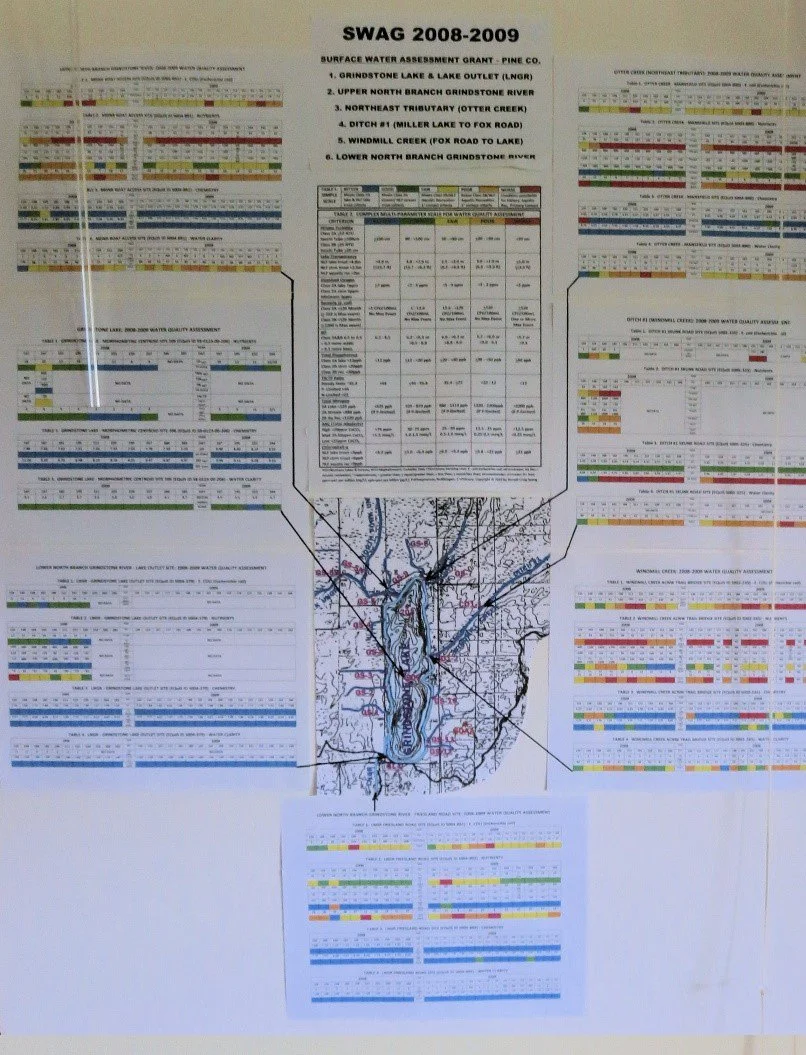
W A T E R
C L A R I T Y &
Q U A L I T Y
Grindstone Lake is one of the deepest naturally formed lakes in Minnesota. As stewards of this amazing resource we are committed to protecting it by monitoring the inputs and the effects on water quality.
2020 - 2022 Update
Years 2020-2022. As the CoVid-19 pandemic is beginning to wane in its third year (this fall and winter will see a spike in cases again unfortunately), coincidentally the 11-year drought cycle is keeping pace powered meteorologically by the sun’s solar cycle. In fact, approximately every 44 years, the drought is especially severe (e.g., Dust Bowl years1932-34, then 1976-1978 and now 2020-2022). However, depending upon where you live on earth, those years are approximate.
But for Grindstone Lake and its 20-square mile watershed, the effects of prolonged droughts on surface water quality are observable. Less precipitation on upland fields and forests minimizes rapid runoff events, which in turn erodes less soil and releases less nutrients (phosphorous and nitrogen) carried by tributaries to Grindstone Lake. Less suspended solids and nutrients entering the lake diminish algal growth, and water clarity improves. Further lake water clarity occurs when the volume of groundwater entering the lake from surface and submerged springs dilutes the diminished volume of tributary surface water. In 2020, the summer average of Secchi disc water clarity improved to 12 vertical feet. The average water clarity increased to nearly 15 feet in 2021, and so far in 2022 the average is similar to 2021. Will this trend continue?
No!
The Grindstone Lake and Stream Study (GLASS) provided a 10-year (2008-2017) water quality assessment required for the Minnesota Pollution Control Agency’s determination of water quality impairment (federal Clean Water Act), which concluded in 2018 that the lake was impaired for nutrients and the main tributaries were impaired for E. coli bacteria. The lake’s Secchi disc water clarity had been incrementally decreasing for more than 20 years to a long-term moving average of 10.5 feet in 2017 in contrast to the non-impaired goal of more than 16 vertical feet.
The current drought is temporarily improving water clarity, but water clarity will still fall far short of the 16-foot goal, especially because wet years will return muddying the waters again. In the 1800s, pioneers claimed that the lake’s water clarity was double that (30 feet plus).
Other water quality parameters, such as chlorophyll-a and total phosphorous, are monitored in assessing impairment, and Grindstone Lake is impaired due to those criteria as well [e.g., chlorophyll-a average 4.3 ppb (should be less than 3 ppb) and total phosphorous average 13.3 ppb (should be less than 12 ppb) – ppb concentration is parts per billion].
And there are many other factors to consider that directly and indirectly impact water quality, including land use and a changing climate. The lake’s Outstanding Resource Value Water (ORVW) protection under Minnesota Law (https://www.pca.state.mn.us/water/outstanding-resource-value-waters) sets high standards for its water quality that will require our concerted efforts to restore and protect.
The GLA is well-positioned to partner with other lake associations, county and state agencies, and public, private and nonprofit organizations that can help advocate for funding. The lake’s thirteen tributaries, as well as runoff from shoreland and malfunctioning and failed septic systems, require our attention because of the significant impact of their poor water quality. Funding is often based upon a 50:50 ratio of grants to volunteer in-kind support. As Grindstone Lake is part of the Kettle River Watershed of the Upper St. Croix River Basin, the Kettle River Watershed WRAPS (Watershed Restoration and Protection Strategy) provides GLA with guidance and a plan to act (https://www.pca.state.mn.us/sites/default/files/wq-ws4-73b.pdf).
“In 2020, the summer average of Secchi disc water clarity improved to 12 vertical feet. The average water clarity increased to nearly 15 feet in 2021, and so far in 2022 the average is similar to 2021. Will this trend continue?”
— Ron Spong


